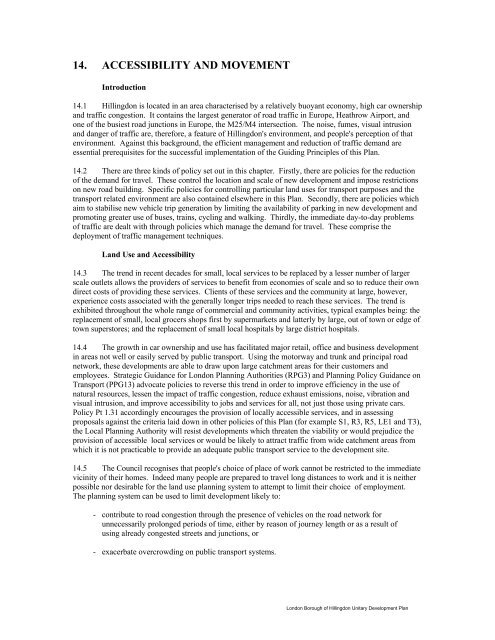HILLINGDON UNITARY DEVELOPMENT PLAN - London Borough ...
HILLINGDON UNITARY DEVELOPMENT PLAN - London Borough ...
HILLINGDON UNITARY DEVELOPMENT PLAN - London Borough ...
Create successful ePaper yourself
Turn your PDF publications into a flip-book with our unique Google optimized e-Paper software.
14. ACCESSIBILITY AND MOVEMENT<br />
Introduction<br />
14.1 Hillingdon is located in an area characterised by a relatively buoyant economy, high car ownership<br />
and traffic congestion. It contains the largest generator of road traffic in Europe, Heathrow Airport, and<br />
one of the busiest road junctions in Europe, the M25/M4 intersection. The noise, fumes, visual intrusion<br />
and danger of traffic are, therefore, a feature of Hillingdon's environment, and people's perception of that<br />
environment. Against this background, the efficient management and reduction of traffic demand are<br />
essential prerequisites for the successful implementation of the Guiding Principles of this Plan.<br />
14.2 There are three kinds of policy set out in this chapter. Firstly, there are policies for the reduction<br />
of the demand for travel. These control the location and scale of new development and impose restrictions<br />
on new road building. Specific policies for controlling particular land uses for transport purposes and the<br />
transport related environment are also contained elsewhere in this Plan. Secondly, there are policies which<br />
aim to stabilise new vehicle trip generation by limiting the availability of parking in new development and<br />
promoting greater use of buses, trains, cycling and walking. Thirdly, the immediate day-to-day problems<br />
of traffic are dealt with through policies which manage the demand for travel. These comprise the<br />
deployment of traffic management techniques.<br />
Land Use and Accessibility<br />
14.3 The trend in recent decades for small, local services to be replaced by a lesser number of larger<br />
scale outlets allows the providers of services to benefit from economies of scale and so to reduce their own<br />
direct costs of providing these services. Clients of these services and the community at large, however,<br />
experience costs associated with the generally longer trips needed to reach these services. The trend is<br />
exhibited throughout the whole range of commercial and community activities, typical examples being: the<br />
replacement of small, local grocers shops first by supermarkets and latterly by large, out of town or edge of<br />
town superstores; and the replacement of small local hospitals by large district hospitals.<br />
14.4 The growth in car ownership and use has facilitated major retail, office and business development<br />
in areas not well or easily served by public transport. Using the motorway and trunk and principal road<br />
network, these developments are able to draw upon large catchment areas for their customers and<br />
employees. Strategic Guidance for <strong>London</strong> Planning Authorities (RPG3) and Planning Policy Guidance on<br />
Transport (PPG13) advocate policies to reverse this trend in order to improve efficiency in the use of<br />
natural resources, lessen the impact of traffic congestion, reduce exhaust emissions, noise, vibration and<br />
visual intrusion, and improve accessibility to jobs and services for all, not just those using private cars.<br />
Policy Pt 1.31 accordingly encourages the provision of locally accessible services, and in assessing<br />
proposals against the criteria laid down in other policies of this Plan (for example S1, R3, R5, LE1 and T3),<br />
the Local Planning Authority will resist developments which threaten the viability or would prejudice the<br />
provision of accessible local services or would be likely to attract traffic from wide catchment areas from<br />
which it is not practicable to provide an adequate public transport service to the development site.<br />
14.5 The Council recognises that people's choice of place of work cannot be restricted to the immediate<br />
vicinity of their homes. Indeed many people are prepared to travel long distances to work and it is neither<br />
possible nor desirable for the land use planning system to attempt to limit their choice of employment.<br />
The planning system can be used to limit development likely to:<br />
- contribute to road congestion through the presence of vehicles on the road network for<br />
unnecessarily prolonged periods of time, either by reason of journey length or as a result of<br />
using already congested streets and junctions, or<br />
- exacerbate overcrowding on public transport systems.<br />
<strong>London</strong> <strong>Borough</strong> of Hillingdon Unitary Development Plan
















